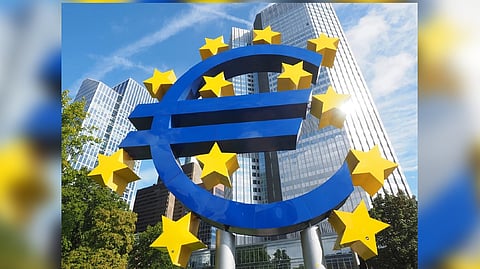

LONDON: Euro zone borrowing costs edged higher on Monday, with the short-dated yields not far off their highest levels in more than a decade as investors were concerned about a hawkish European Central Bank and increasing bond supply.
Analysts said more public spending to fight the adverse impact of the energy crisis might raise the 10-year Bund yield to as high as 2.7% in 2023 because of increased government funding needs while excess liquidity falls.
The ECB pledged further rate hikes to fight inflation but also announced it would start reducing its 5 trillion euro bond holdings from March. Germany's 10-year government bond yield, the bloc's benchmark, rose 2.5 basis points (bps) to 2.19%.
The German 2-year yield, most sensitive to changes in policy rates, dropped 1.5 bps to 2.43%. It reached its highest since November 2008 at 2.50% on Friday. Italy's 2-year yield was up 1 bps at 3.13%. It hit its highest since August 2012 at 3.39% on September 28.
ECB's hawkish comments and strong economic data from Germany propped up euro zone yields. Interest rates will not only need to go to restrictive territory but stay there longer, ECB's Slovak policymaker Peter Kazimir said on Monday.
The likelihood of a recession in Germany has fallen with the release of a survey on Monday showing a stronger-than-expected rise in business morale in Europe's largest economy in December. BofA sees a terminal deposit rate at 3.50%, with a 50 bps rate hike in February and March 2023 and two more 25 bps hikes in May and June.
ECB euro short-term rates (ESTR) September 2023 forwards were at around 3.3%. "The big picture remains the same: we think the ECB is at serious risk of overdoing the tightening and ending up destroying more demand than is necessary to bring inflation back to target," said Ruben Segura-Cayuela Europe Economist at BofA.
The German yield curve was inverted, with the gap between 2-year and 10-year yields at -24 bps. It briefly hit a fresh 30-year low at -41.9 bps on Friday. An inversion suggests that investors expect the ECB to pause its hikes or even cut rates in the future as inflation will start declining faster than expected or because the central bank wants to avoid deepening a recession.
"With recent events fuelling bearish rates and quantitative tightening (QT) expectations, the backdrop for long-end supply over the first weeks of the new year looks set to become even more challenging," Rainer Guntermann rates strategist at Commerzbank said. The ECB said it would start reducing its large holdings of government debt, in a move often called quantitative tightening, from March 2023.
Some analysts expect reinvestments to stop entirely after June, although the emergence of stress on peripheral sovereign debt might change this view. Italy's 10-year government bond yield rose 6 bps to 4.36%, with the closely watched spread between Italian and German 10-year yields widening to 216 bps.
Visit news.dtnext.in to explore our interactive epaper!
Download the DT Next app for more exciting features!
Click here for iOS
Click here for Android